This paper provides dates, transcriptions, captions, and some context for eighty-four postcards that L.M. Montgomery mailed to George Boyd MacMillan during the years of their long-term correspondence. This inventory also includes four postcards that MacMillan sent to Montgomery.
Introduction
L.M. Montgomery and George Boyd MacMillan (1881–1952) wrote numerous letters to each other between 1903 and 1941. Besides letters themselves, the correspondents mailed other print items: books, bundles of magazines and weeklies, clippings, and postcards. Few mailings from MacMillan (GBM) seem to have survived—Montgomery (LMM) used several of his cards as bookmarks, and some of those have been saved. However, the material that Montgomery mailed to Scotland was preserved due to the stewardship of the McMillan family (George B. changed the spelling of his name). George B. MacMillan placed his Montgomery collection in the hands of his niece and nephew, Greta and George McMillan who lived in Clackmannan, a few miles from their uncle’s home in Alloa, Scotland.
In 1974 Greta and George McMillan made arrangements (through Montgomery biographer Mollie Gillen and G.B. MacMillan’s friend John Gardner) to place L.M. Montgomery’s letters and other material in the Library and Archives Canada (LAC) in Ottawa. Included in the LAC collection are twelve picture postcards sent during the last years of Montgomery’s life. In 1989, the twenty-three first-edition books that Montgomery wrote and sent to MacMillan as gifts were purchased by the Archival and Special Collections at the University of Guelph Library, Ontario, from bookseller Cooper Hay Rare Books in Glasgow, Scotland. In 2019 Dr. Donna Jane Campbell purchased seventy-two postcards and additional material from Duncan McMillan, a descendant of Greta McMillan. Dr. Campbell donated the full collection, as the George Boyd MacMillan Family Collection, to the L.M. Montgomery Institute with the intention of having the images made available to the public through the KindredSpaces archive (funded by Dr. Campbell for the LMMI through the Robertson Library, UPEI).1 Across all of the collections, eighty-four picture postcards written by L.M. Montgomery have been preserved in addition to her one hundred letters and notes.
While postcards were in circulation in the late 1890s, the use of “divided-back” picture postcards (with half of the card for an address and half for a message) was not authorized by postal services, such as the General Postal Union in Canada, until 1902 in Britain and 1903 in Canada.2 Many of the Prince Edward Island cards that were available to Montgomery in Charlottetown were from the “Canadian Souvenir PostCard” and “Garden of the Gulf” series, published by Warwick Brothers and Rutter, Toronto, and photographed by W.S. Louson and W. Cumming. Other publishers were Carter and Co., Charlottetown, PEI.; McCoy Printing, Moncton, New Brunswick; Valentine Black Co., Toronto; and PECO, Photogelantine Engraving Co., Toronto.3
MacMillan sent postcards from the start, which Montgomery acknowledged in her second letter to him on 7 April 1904. Montgomery’s first postcard was written 21 May 1904 on a divided-back card. However, her next four cards had no space for messages and simply showed photographs of locations in Charlottetown. Montgomery mailed seventy per cent of the picture postcards to Scotland while she lived in Prince Edward Island, before she was married. While MacMillan was sending her welcome images of lochs, mountains, castles, and the homes of Robert Burns and Walter Scott, she was happy to share images of PEI, Nova Scotia, and Canada with whatever cards she could find in Charlottetown, even those with pictures of moose camps in Ontario. In all, fifty-five per cent of her cards represented Atlantic Canada.
Not all of the cards had written messages, but when they were present they were short, somewhat like slow-motion “texting.” One or two sentences sufficed to acknowledge receipt of his gifts or letters, to respond to his comments or questions, to promise to write soon, or to announce a baby’s arrival. They also were enough to reveal when she was busy/housecleaning, what the weather was like, or how to plant bulbs, for example.
The postcards are essential place markers within the entirety of the Montgomery-MacMillan correspondence. Many of the cards include dates on the postmarks or in the script, but on some cards those dates are not legible. When both dates are visible they reveal that postcards mailed from Cavendish, PEI, to Alloa, Scotland, took about ten days to arrive, so when the Alloa postmark is visible it is possible to estimate the date the card was written or sent. In the early years of the correspondence LMM and GBM exchanged letters about every three months. After Anne of Green Gables was published Montgomery wrote twice a year and then gradually the intervals increased to long letters every two years. The frequency of cards followed this same pattern: Montgomery sent fewer cards after she moved to Ontario.
Placing the cards in the correct chronological order is helpful in illuminating the context of both card and letters, and some postcard messages can be explained by reading her letters. An example is one of her last cards sent 11 July 1939. It is a beautiful picture of Casa Loma in Toronto. The context for this card can be found in her letter of 7 March 1939; she reminisced about meeting MacMillan for the first time by the Glasgow Exhibition tower in 1911 and taking in the view of York from the top of the York Minster tower later on her honeymoon. He may have replied with descriptions of (castle) towers he climbed, and her Toronto castle response is meaningful as part of that conversation.
Montgomery shared a bit of local history on the card from 11 July 1905, which pictured cannons at Fort Edward, Victoria Park, Charlottetown. Her brief summary read, “Old cannons used in famous siege of Louisberg [sic] and fished up out of harbor after 160 years immersion.” Montgomery was right about some of it. The fortress of Louisbourg is located on Cape Breton Island, Nova Scotia, and was the site of a series of battles for control of the area between Britain and France in the mid-eighteenth century. The cannons that Montgomery shared here, “the Prince Edward Battery,” were never used in battle but were fired for ceremony and practice. Of the six guns that Montgomery saw in the photograph, three were installed in 1866 and three others installed in 1901.4 It was another cannon, not pictured in the Victoria Park postcard, that came from a sunken French ship and was retrieved from Louisbourg harbour in 1900. This cannon was on display at Province House in Charlottetown in 1905 until it was moved to the Acadian Museum in Miscouche, PEI, in 1999, its history inscribed on an accompanying plaque. Montgomery might have been repeating local lore which confused the history of this authentic cannon with the ones displayed in the park.
Many of the pictures on the cards have no apparent context and may have been chosen because they were what she had on hand. Her card of 27 April 1908 has a photograph of a constructed overlook tower at the top of High Rock in Maryland, USA, by the Appalachian Trail and Blue Ridge Mountains. Montgomery may have been collecting cards wherever and from whomever she could, but, so far, no connection to this resort area is apparent. However, the presence of this particular image should be a happy coincidence for the founder of the L.M. Montgomery Institute, Elizabeth Epperly, who was born 300 miles south from High Rock near the foothills of this same mountain range.
Another curious example of a card seemingly without context is the one dated 4 October 1917. The photo on it is the home of Lt. Col. Samuel Sharpe (1873 to 25 May 1918) who was a friend of Maud and Ewan Macdonald and the heroic commander of their local army unit, the 116th Battalion, CEF. When this card was written during World War I his troops were about to be moved into position for the Allied attack at Passchendaele. By February 1918 Sharpe suffered a breakdown from battle fatigue and was sent back to Canada where he took his own life.5 This postcard has a great deal of context, but Montgomery never mentioned Sharpe in any of her letters or explained the photo on it. Her message here in October 1917 was an inquiry about whether MacMillan had received her new books: Anne’s House of Dreams (released 24 August 1917) and The Watchman and Other Poems (November 1916).
These cards provide evidence of how highly she valued MacMillan’s friendship. (She dedicated Emily of New Moon to him).6 Until these postcards surfaced, scholars wondered why she did not tell him that her first book, Anne of Green Gables, was going to be published until a letter in September 1907, five months after her manuscript was accepted by a publisher, L.C. Page. However, her postcards reveal she did notify MacMillan immediately. Her acceptance letter from Page was written on 8 April 1907, and she wrote in her journal that the letter arrived on 15 April.7 On 16 April, to announce the good news, she mailed a postcard to Mr. MacMillan with a picture of the icebreaker steamship, Stanley. (Icebreakers were essential for getting mail to the Island in winter.)
Montgomery received her copies of Anne of Green Gables on 20 June 1908. A few days later, on 24 June 1908, she wrote to alert MacMillan that she was sending him the new book. The picture on that card was the house of “Sam Slick,” a very popular character created by Thomas Chandler Haliburton and main character of The Clockmaker, which was Canada’s first international bestseller. Anne of Green Gables was soon to follow on the bestseller list.8
The postcard messages represent only about one per cent of the 165,000 words of text in Montgomery’s letters. However, the postcards recently added to the collection in Prince Edward Island and on KindredSpaces9 can enhance our understanding of Montgomery’s correspondence and friendship with MacMillan through the texts or images or both. Like her scrapbooks and photographs, these short messages illuminate small corners of her day-to-day life. We can continue to be intrigued by the many aspects and artifacts of L.M. Montgomery; we are never safe from being surprised.
Transcriptions
On 22 November 2019 I received an unexpected phone call from Betsy Epperly with the unbelievable news that a new batch of L.M. Montgomery’s correspondence with George B. MacMillan had been discovered in Scotland. It was a breathtaking moment, and it did take a few moments for me to breathe and let the news sink in. During a long and animated conversation, we discussed how such a collection might be appraised and acquired between exclamations of “I can’t believe this!” Soon afterward, Epperly contacted Donna Jane Campbell (who has enriched the holdings of the L.M. Montgomery Institute for years) and the MacMillan Family Collection began to be formed with her help. The timing was providential because I had recently finished transcribing and annotating all 102 of Montgomery’s letters and notes to MacMillan, and Betsy had written the preface for the manuscript of my book proposal. She told me that I was not finished yet! I was sworn to secrecy about the discovery for four months until the official announcement was made, but my silence was amply rewarded.
The precious cargo of MacMillan material arrived on the University of Prince Edward Island campus on 18 March 2020, just two days after a public-health emergency was declared on the Island because of the COVID-19 pandemic. The campus began to close down but not before University Archivist and Special Collections Librarian Simon Lloyd quickly took photos of the postcards with his phone. I had planned to fly to Prince Edward Island and view the collection myself, but that could not happen during the pandemic. Simon shared all his photographs of the postcards with me on 31 March 2020, and they were good enough for me to begin to date and transcribe them during the long quarantine and insert them into my manuscript. Since then, high-quality images of most of the postcards have been uploaded to KindredSpaces. I shared parts of the first draft of the transcriptions with Elizabeth Epperly, Jenny Litster, and Carolyn Strom Collins, who helped decipher some of Montgomery’s handwriting and meaning.
Eighty-four cards from L.M. Montgomery and four cards from G.B. MacMillan
21 May 1904
An old fashioned P.E.I. church. Why are cemetery monuments always so hideous?
This isn’t a conundrum.
LMM
Postcard Caption: Belfast Church Near Eldon, PEI.
2 November 1904
No text.
Postcard Caption: [South African] Soldier Monument, Charlottetown.
21 November 1904
No text.
Postcard Caption: Great George Street, looking from Queen Square, Charlottetown.
12 June 1905
No text.
[On front of card] Greeting.
Postcard Caption: From the land of the Maple. View in Queens Square Gardens, Charlottetown, P.E.I.
3 July 1905
No text.
Postcard Caption: Queen Square Gardens, Charlottetown.
11 July 1905
July 11 “Loch Lomond” card to hand. Lovely. Yes, it is No VI of “superstitions” I have. Old cannons used in famous siege of Louisberg and fished up out of harbor after 160 years immersion.
L.M.M.
Postcard Caption: Charlottetown from Fort Edward.
Context: This is a reference to her 15 March 1905 letter: “And I can’t tell you how much I’m enjoying “Superstitions” in your paper [Alloa Journal and Clackmannanshire Advertiser]. I’ve always revelled in the legends of fairies and elves.”10
As noted above, the fortress of Louisbourg is located on Cape Breton Island, Nova Scotia, and was the site of a series of battles between Britain and France for control of the area. A plaque at the Acadian Museum in Miscouche, PEI, is beside one of the cannons from one of the French ships sunk in 1758 and states that it was retrieved from the Louisbourg harbour in 1900 and put on display at Province House in Charlottetown in 1901. (It was moved to Miscouche in 1999.) The cannons at Fort Edward in Victoria Park, “the Prince Edward Battery,” were never used in battle but fired for ceremony and practice. Three of the guns were replaced in 1901.11
13 July 1905
Letter received. Will answer soon. Just in dog-days here—too warm for gray matter to work well.
L.M.M.
Postcard Caption: St. James Presbyterian Church, Charlottetown.
24 July 1905
Your Lochleven card to hand. By odd coincidence I was reading Scott’s “Abbot” the very day it came.
L.M.M.
Postcard Caption: Law Courts Building, Charlottetown.
Context: The Abbot (1820) by Sir Walter Scott ends with the escape of Mary, Queen of Scots, from Lochleven Castle.
1 August 1905 [CARD FROM G.B. MACMILLAN]
I am writing this card in the room you see portrayed here. The bed in the corner was where the poet was born. Homely place isn’t it? [P.S. This pen might have been the one used by the poet too: it is so beastly scratchy!]
GBM
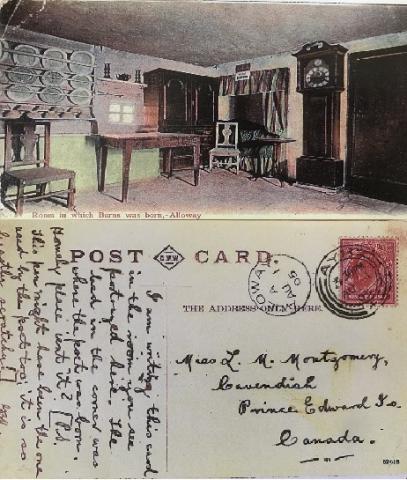
Postcard Caption: Room in which Burns was born,—Alloway.
About 10 June 1906
Just home from a flying trip to town. It is June-time and everything lovely.
L.M.M.
Postcard Caption: Charlottetown’s Beautiful Harbor, Prince Edward Island.
27 June 1906 [CARD FROM G.B. MACMILLAN]
Here for our Printer’s Annual Excursion. The town is Doune. If you have read “Waverley” (as I have no doubt you have) you will remember that it was to Doune Castle that the hero of that story was conveyed by the Highland captors, after the escape from Gilfillan and his band.
Your post card of Charlottetown Harbour was magnificent. I liked the rainbow sheen on the water.
GBM.
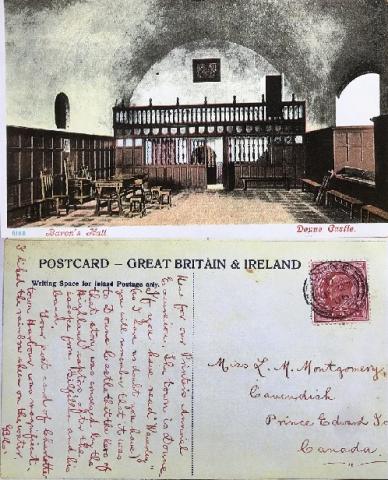
Postcard Caption: Baron’s Hall Doune Castle.
Context: He is responding to her postcard 10 June 1906.
30 June 1906
Your letter just received. The Scott Oak card is lovely. I accept it with unquestioning faith & use it as a bookmarker for Waverley.
L.M.M.
Postcard Caption: Avenue near Charlottetown, P.E.I.
Context: She wrote a similar sentence in her letter 29 July 1906. Inside her copy of Waverley she pasted a clipping about Scott on the title page and a piece of this “[red] oak” postcard, from a tree planted by Scott.12
About 9 October 1906
Not especially seasonal, perhaps you could say? But isn’t beauty seasonal all year round? Just been to town so got a few cards. This reproduced from genuine photo.
L.M.M.
Postcard Caption: A Breath of Spring Prince Edward Island.
Context: A magazine clipping of this image is in her Red Scrapbook.13 The Island photographer was W.S. Louson.14
24 October 1906
Your letter just received. The picture of Tantallon Castle is exquisite—the prettiest you have sent. Am sending a typical P.E.I. autumn scene.
L.M.M.
Postcard Caption: Harvest Scene Prince Edward Island.
15 November 1906 [CARD FROM G.B. MACMILLAN]
Here’s a card which I procured to send you some time ago, but somehow or other it has always been left over in favour of later ones. What do you think of our Scotch firs? Isn’t this group lovely? Enough to confirm you in your belief in tree-personality! Thanks very much for the two lovely cards you sent recently. They were beauties, especially the “Breath of Spring.” I prize both very greatly. Am expecting your letter by every mail now! With kindest regards.
Yours sincerely GBM.
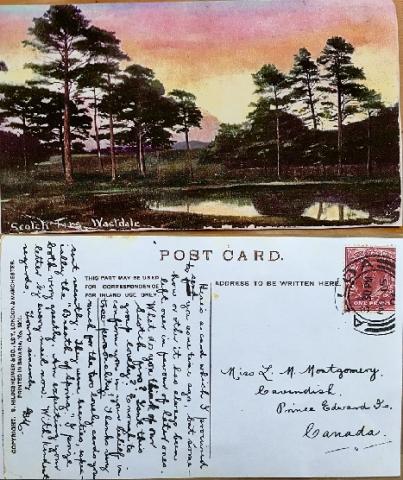
Postcard caption: Scotch Firs, Wastdale.
Context: He is responding to her postcard 9 October 1906.
3 December 1906
These are French Canadian descendents of the exiled Acadians of Longfellow’s famous poem “Evangeline.” There are many of them here.
L.M.M.
Postcard Caption: Five Generations All Pullers Together Prince Edward Island.
Context: Photo of Cole Poirier and the names and ages of his family.
13 April 1907
Thanks for the postal of River Tweed. This is a Nova Scotian card.
L.M.M.
Postcard Caption: Halifax, N.S. Monument to South African Heroes, in Public Gardens.
16 April 1907
Just received word today that I have had a book MS accepted by prominent American publishing firm.
L.M.M.
[On front of card] Typical winter scene in our strait!
Postcard Caption: Icebreaker “Stanley” crossing to the Mainland from P.E.I.
Context: Icebreakers were vital for getting mail to the Island in winter months.
LMM received a letter from L.C. Page on 15 April (written on 8 April 1907) accepting her manuscript of Anne of Green Gables for publication. This card is evidence that she wrote her good news to GBM on 16 April immediately after the letter arrived.15
8 May 1907
We have spring here now. Hope your seeds will grow. I’m busy potting plants too.
L.M.M.
Postcard Caption: A Cool Retreat, Montague, P.E.I.
3 June 1907
Am so glad you had a cold May and snow ’cause it puts me in conceit with Island again. We have had very cold May and a regular snowstorm one day.
L.M.M.
Postcard Caption: Parliament Building from Nepean Point, Ottawa.
19 June 1907
Have you read Longfellow’s “Evangeline.” If so, you’ll “recognize” this famous spot—the little village of Grand Pre.
L.M.M.
Postcard Caption: Grand Pre Village, N.S.
24 June 1907
No text.
Postcard Caption: Drive In Point Pleasant Park Halifax, N.S.
Context: In her previous letter of 1 April 1907, she mentioned working in Halifax. Between her letters of April and September 1907 she sent nine postcards.16
29 July 1907
This is a spot not far from here. Your letter received yesterday. We are having just as cold and damp a season as you. Don’t thin the poppies out.
L.M.M.
Postcard Caption: North Shore, Prince Edward Island.
About 25 August 1907
A scene in our neighboring province of Nova Scotia.
L.M.M.
Postcard Caption: Sutherland’s River, near Stellarton, N.S.
About 29 August 1907
Thanks for magazines and poem leaflets. This is an Ontario scene. Shall be writing soon.
L.M.M.
Postcard Caption: Smoking Moose Meat, Kipawa Lake.
Context: Lake Kipawa is in southwest Quebec, Canada, near the border with Ontario.
She begins her next letter on 11 September.
About 12 September 1907
Thanks for Sir Walter’s favorite view. This is a Nova Scotian scene. Wrote last week.
Sincerely L.M.M.
Postcard Caption: “Evangeline”.
Context: The view that MacMillan sent would have been toward the Eildon Hills across the valley of the River Tweed where Melrose Abbey once stood.17
12 October 1907
No text.
Postcard Caption: St. Paul’s Church, Halifax.
21 October 1907
You see we have mountains in Canada too. The Rocky Mt. scenery is considered to be finer than Alpine scenery. Have never seen either myself but hope to see both someday.
L.M.M.
Postcard Caption: Hermit Mountain, View from Grade, 1½ Miles West of Rogers’ Pass, British Columbia.
11 November 1907
“[and] Away to the northward
Blomidon rose and the forests old, and aloft
on the mountains
Sea-fogs pitch their tents.”
Longfellow.
Postcard Caption: Cape Blomidon, N.S. Dominion Atlantic Railway.
Context: This quote is from Evangeline, A Tale of Acadie by Henry Wadsworth Longfellow, 1847.
19 November 1907
The “Seven Sisters” are beautiful. I envy their owner. Is he their owner. That is, does he get any enjoyment out of them?
L.M.M.
Postcard Caption: Around the Camp Fire, Algonquin, National Park, Ontario.
Context: This reference could be about a group of trees near Alloa, a landmark located in the current Alloa Golf Club, Schawpark. The golf course was established in 1935, and the fifteenth hole is named Seven Sisters.18 GBM must have sent her a postcard of trees at this location. Schawpark, owned by the Earl of Mansfield, is mentioned in her letter of 29 August 1926.
About 27 December 1907
With best wishes for a Happy New Year.
L.M.M.
Postcard Caption: Rockliffe [Rockcliffe] Park, Ottawa.
30 January 1908
No text.
Postcard Caption: Moose Hunter’s Camp, Kipawa Lake ONT.
Context: LMM wrote a letter on 8 January 1908, continuing their discussion of love, which has no apparent connection to another moose-camp card.
10 March 1908
No text.
Postcard Caption: Pownall Bay, Prince Edward Island [also spelled Pownal].
27 April 1908
Many thanks for beautiful sea scenes. I am out of nice cards till I get to town. Do you know a Mr. Cochrane who lives five miles from Alloa—a mechanical engineer? He is just out from Scotland. Says he knows a McMillan in Alloa who is an engineer. Any relation of yours? Best wishes for a pleasant summer.
L.M.M.
Postcard Caption: High Rock, Pen Mar, Blue Ridge Mountains.
Context: Pen Mar Park was a popular resort area in 1900 on the border of Maryland and Pennsylvania.19 How Montgomery acquired a 1908 card that featured a Blue Ridge Mountain landmark is not known.
6 June 1908
In town recently and tried to get some new Island views but could only get old ones. This is a Nova Scotia scene.
L.M.M.
Postcard Caption: Gaspereaux River Above Grand Pre.
24 June 1908
Am sending a copy of the book today. Hope you’ll like it but don’t say you do if you don’t. Your letter received lately. Will answer sooner than you deserve.
L.M.M.
Postcard Caption: Sam Slick House Windsor N.S.
Context: Sam Slick was a very popular character in The Clockmaker: The Sayings and Doings of Samuel Slick of Slickville (1838), a book by Thomas Chandler Haliburton, Canada’s first international bestseller.
LMM sent MacMillan a first edition, first impression (April 1908, beige boards) of Anne of Green Gables.20 She must have received a box of them. In later years she gave publishers a list of people who should receive complimentary copies.
2 July 1908
We are having weather to match yours—never knew such a lovely June. Am sending a different style of card.
L.M.M.
Postcard Caption: Montreal Harbor.
14 July 1908
We are being roasted alive. But are having lovely swims and surf dips—and roses.
L.M.M.
Postcard Caption: Franklin Statue, Boston, Mass.
Context: LMM received her copy of Anne of Green Gables on 20 June.21 The offices of her publisher, L.C. Page, were in Boston, which may account for the card picturing Benjamin Franklin. She did not visit Boston until 1910.
19 August 1908
This is a new one “The Rhine of America.” Am going to answer your letter very soon. Have been so busy. Finished second “Anne” book the other day.
L.M.M.
Postcard Caption: Boar’s Head, St. John River, N.B.
Context: The river had been called “The Rhine of America” since at least the 1870s.
She finished Anne of Avonlea on 3 August 1908.
2 September 1908 [CARD FROM G.B. MACMILLAN]
Here’s something that will interest you as a Canadian. I am at present on holiday and have been visiting the Exhibition at Edinburgh. It is a lovely sight. They have a fairy fountain which I feel sure would give you ecstasies. Wish you had been there to see it! Will endeavor to describe in my next letter. Am sending you this by mail, a novelty in postal souvenirs which I trust will give you pleasure.
Regards GBM

Postcard caption: A Corner, Big Game, Canadian Pavilion, Scottish National Exhibition, Edinburgh, 1908.
8 September 1908
Aren’t these curious “freaks of nature?” We too have had a lovely summer and fine crops. Your “snow scene” is beautiful. Wrote you last week.
L.M.M.
Postcard Caption: Nature’s Monuments, Hopewell Cape Rocks, New Brunswick.
Context: She finished a letter on 1 September.
14 September 1908
“Edinburgh in a nutshell” to hand. Alas, the shell was in fragments and Edinburgh lost. Absit omen. Am very busy typewriting Ms. of new book. Having a lovely autumn.
L.M.M.
Postcard Caption: Flower Pot Island, Georgian Bay, Canada.
Context: A popular souvenir of World’s Fairs in the 1900s featured a nutshell to house an accordion-style fold-out of a drawing or document. Edinburgh was the host city of the Scottish National Exhibition in Saughton Park which ran from May to October 1908 and where souvenirs like this may have been sold. An example of this souvenir can be seen at commons.wikimedia.org, “1904 World’s Fair Souvenir World’s Fair in a Nutshell.”
She was typing her handwritten manuscript of Anne of Avonlea.
29 September 1908
Bibby’s Annual to hand. It is finely gotten up. Thanks ever so. Our lovely weather continues.
Am busy typing my new book Ms.
L.M.M.
Postcard Caption: Scene at Keppoch, Prince Edward Island.
Context: LMM continues to type Anne of Avonlea.
4 December 1908
Am sending today the third and concluding volume of the “Breakfast Table” series. Greetings of the season.
L.M.M.
Postcard Caption: Buffalo at Banff, Western Canada.
Context: Oliver Wendell Holmes (1809–1894), The Poet of the Breakfast Table (1872).
About 5 December 1908
Bibby’s Annual received. Thanks for it. It is very fine. We are having a “cold snap.” I have a box of white narcissi out in bloom that keeps summer in house.
L.M.M.
Postcard Caption: Valley of 10 Peaks, Rocky Mountains, Western Canada.
About 6 December 1908
“Silver Glen” received. It is very pretty. Am feeling somewhat better and hope you are too.
L.M.M.
Postcard Caption: Natural Steps, Montmorenci near Quebec, Can. [also spelled Montmorency].
14 April 1909
Good for daffodils! Your springs are a month earlier than ours. Rec’d your letter. Will write sooner than you deserve and will advise as to further treatment of daffodil. Meanwhile leave it alone.
L.M.M.
[On front] Wouldn’t you like to lie and dream among those buttercups and daisies?
Postcard Caption: The Border of the Woods, Prince Edward Island.
Context: LMM’s last letter to him was sent in early September 1908, followed by short notes in October, November, and December.22 Although he sent her a Christmas gift she appeared to dish out some playful “scolding,” as she did on 24 June 1908 when she had to wait for his letters.
5 May 1909
Busy housecleaning!!!
L.M.M.
Postcard Caption: Fisherman’s Paradise, Dunk River, P.E.I.
Context: “Busy housecleaning” may be a way of saying “will write soon.” She began her next letter on 21 May.
23 August 1909
“Edinburgh in Nutshell” came safely this time. Have been trying for a fortnight to get time to answer your letter. Hope to succeed soon.
Yours etc.
L.M.M.
Postcard Caption: Orchard Scene, Land of Evangeline, N.S.
19 October 1909
Ghost article and card received. What is reality behind the affair? Suppose card is merely a “fake” ghost.
L.M.M.
Postcard Caption: Cape Blomidon, Land of Evangeline.
Context: She may be referring to an article about spirit or psychic photography (double exposure) which was becoming popular at that time. An organization of spirit photographers called the Crewe Circle was formed in 1906 and images and testimonials by photographers were becoming widespread in 1909.23
6 January 1910
Thanks for “The Golden Age.” It is lovely. Will write when I get time for a good letter.
L.M.M.
Postcard Caption: Young Women’s Christian Association, Colombo, Ceylon [Sri Lanka].
Context: The Golden Age. Kenneth Grahame (1859–1932). Stories of childhood first published in 1895.
About 22 March 1910
Yes, spring is coming here too—but we have had a lovely winter. Am busy with Kilmeny proofs.
L.M.M.
Postcard Caption: No printed caption—a drawing of a ship labelled “Good Fellowship” with a rhyme about good wishes.
10 May 1910
Thanks for “ephemeral literature.” Shall be sending you a copy of “Kilmeny” soon.
We have a lovely spring.
L.M.M.
P.S. Isn’t it sad about the King!
Postcard: L.C. Page promotional postcard of Kilmeny of the Orchard.
Context: King Edward VII died 6 May 1910.
20 June 1910
Letter, review, and “Dream Day” rec’d. Enjoyed all three. Will write soon—in the busy woman’s sense of “soon.”
L.M.M.
[On front of card] near Cavendish
Postcard Caption: Road Near New Glasgow, P.E. Island.
Context: Mt. Tom Road, New Glasgow. The woman has been identified as Ella Jean Bagnall Simpson (1874–1960) by her grand-nephew, Carson Smith, New Glasgow, PEI, in a comment on Facebook group, “Earles Picture Restoration Prince Edward Island,” 21 January 2017.
27 June 1910
The “Anne” slips and Gazettes to hand. The latter are very interesting and amusing. Many thanks.
L.M.M.
Postcard Caption: Parliament Buildings, Toronto.
4 July 1910
“Alva Glen” lovely. I envy you your mountains. I feel that I’d love mountains if I had half a chance to get ’quainted with ’em.
L.M.M.
Postcard Caption: Pulpit Rock, Point Prim, P.E.I.
Other versions of this card have been captioned “Land’s End.” It was published by The Pugh Manufacturing Co. Ltd., Toronto.
8 September 1910
Your card to hand. We have had uncommonly cool summer too. I have a letter half written to you. Hope to finish it sometime.
L.M.M.
Postcard Caption: Macdonald Hall, O.A.C. (Ontario Agricultural College), Guelph, Ontario.
Context: This card is dated 8 September, and the letter she mentions was begun on 1 September.
Macdonald Hall was the residence for women enrolled in the Macdonald Institute’s domestic science program established in 1903. The building and program were named after donor, William C. Macdonald, a philanthropist who was born in Prince Edward Island.24 Montgomery’s closest friend, Frederica Campbell, attended the University of Guelph in April 1907, to take coursework in Nature Study—“to study bugs and other uninteresting objects.”25
24 October 1910
“Louise” was a mere guess of editor. Thanks for Bibbys. It is fine. Am sending you a couple of daffodil bulbs—different varieties.
L.M.M.
Postcard Caption: Moonlight, North River, Charlottetown, P.E.I.
Context: LMM may have been referring to an editor who could not read her handwriting and made an incorrect guess at a word.
15 October 1910
Gazettes and Punch received & much enjoyed. We are having a wet stormy October. Will be sending you a couple of bulbs soon.
L.M.M.
Postcard Caption: Trout Fishing P.E.I.
26 November 1910
Just returned from a short visit to Boston, as guest of my publisher.
L.M.M.
No caption [large boat, men rowing].
23 July 1911
We had a delightful trip to Iona and Staffa. Fingal’s Cave alone was worth the trip. We go to Ayr tomorrow and next day to the Trossachs. We got our letters last night.
L.M.M.
Postcard Caption: Tombs of the Kings and Iona Cathedral.
Context: This is one of two postcards mailed during the Macdonald’s honeymoon trip in Scotland. LMM was in touch frequently with GBM, sending five letters and notes before and after they spent a few days together in Alloa and a week in Berwick.
31 July 1911
Pardon this card and pencil. Am writing this before leaving for Melrose to acknowledge your letter. We go north tomorrow to be away until Saturday but send mail to this hotel. We will go to Alloa as arranged. Will write you whenever we [are] back here.
LMM
Postcard Caption: Ghillie Callum, The Sword Dance.
16 March 1912
This is a scene near my new home. The “Punch” etc. to hand. Many thanks. The motor poems from “Ghent to Aix” were good. Mr. M. sends regards.
L.M.M.
Postcard Caption: Park Drive, Uxbridge.
Context: Robert Browning (1812–1889), How They Brought the Good News from Ghent to Aix, 1845. Jennifer Litster suggests that MacMillan wrote poetical parodies of Browning’s poem “that reimagined the ride from Ghent to Aix in the age of the car.”26
28 July 1912
This is a glimpse of “The Thunder of waters.”
L.M. Macdonald
Postcard Caption: Prospect Point, Niagara Falls.
Context: Her first use of her married name.
In May, LMM and her cousin, Stella Campbell, visited Niagara Falls. LMM described the Falls in her letter of 27 June 1912. She does not announce the birth of her son, Chester, who was born on 7 July, until her letter on 18 August.
23 June 1913
I leave for a five weeks trip to “The Island” next week. Will write you on return. Thanks for papers. The Daily Sketch is very interesting.
L.M. Macdonald
Postcard Caption: [Elgin] Park Pond, Uxbridge.
29 July 1914
Thanks for last two postals. They are among the most charming you have sent me. Letter and papers also to hand. Have been doubly busy of late. A pleasant vacation to you.
L.M.M.
Postcard Caption: Sandbar at Sturgeon Point, Kawartha Lakes, near Lindsay, Ont., Canada.
Context: In her correspondence, LMM sometimes referred to postcards as "postals."
8 September 1914
Your card received. Also Daily Sketches for which many thanks. I shall be answering your letter soon. This war is dreadful. Have you seen Kipling’s fine poem?
L.M.M.
Postcard Caption: This is a Hint from Leaskdale, ONT. That You are Wanted Here.
Context: The United Kingdom declared war on Germany on 4 August 1914. Canada was a British Dominion, bound to the foreign policy decisions of the British Parliament which made it a partner in the war effort.
Rudyard Kipling’s poem “For All We Have and Are” was first published in The Times (London) on 2 September 1914.
22 November 1915
Received your letter. Will write soon. We have a new baby boy here born October 7th. Sorry to learn you were not very well. We are all feeling the dreadful strain of the war.
L.M. Macdonald
Postcard Caption: 1000 Islands, St. Lawrence River.
Context: Ewan Stuart Macdonald, 7 October 1915 to 9 September 1982.
LMM did not take a cruise on the St. Lawrence Seaway until 1919.
23 May 1917
Your cards to hand. Yes, your photo came and was much appreciated. It is very good. We are busy gardening. A late cold spring. Thanks also for Scotsman with Watts article.
L.M.M.M.
Postcard Caption: The McIntyre Fountain, Winona Lake, Ind.
Context: On 14 September 1916, the Macdonalds visited Ewan’s brother, Dr. Angus Macdonald, in Warsaw, Indiana. His wife took LMM to see Winona Lake.27 Dr. (Rev.) Lauchlan MacLean Watt (1867–1957) was a friend of MacMillan’s. Watt wrote poetry and books including several during World War I. He was a minister in Alloa, 1901–1911, and became the Moderator of the General Assembly of the Church of Scotland in 1933.28
4 October 1917
Your card to hand also packet of Gazettes. Many Thanks. Shall look for a letter soon. Did you get the copy of my new book, also the copy of my book of poems?
L.M. Macdonald
Postcard Caption: Col. Sharpe’s residence, Uxbridge.
Context: Her new books were Anne’s House of Dreams and The Watchman and Other Poems.
Lt. Col Samuel Sharpe (1873 to May 25, 1918) was a friend and neighbour, a lawyer, a Member of Parliament, and the heroic commander of the local army unit, the 116th Battalion, CEF. He fought at Vimy Ridge in March 1917, at Lens/Hill 70 in August and September, and at Passchendaele in October. Sharpe suffered a breakdown from battle fatigue and was sent back to Canada in 1918, where he took his own life. LMM does not mention him in any of her letters or cards.29
Early 1928 [dated by similar winter reference in 6 February 1928 letter and stamp value]
Many Thanks for Bibby’s Annual and Gazettes. We are having a strange winter—no winter at all in fact. Good luck.
L.M.M.
Postcard Caption: The Capitol, West Front, Washington, D.C.
About February 1928 [dated by an identical reference to this poem in her letter of 6 February 1928]
Dear Mr. McMillan:—
Sometime ago you asked me for another copy of “Fate.” Mine has turned up so I enclose a copy of it. If we “live in deeds not years, in feelings not in figures on a dial” the world is many centuries older than when I wrote you. I can never forget the agony of the first reports of the naval battle.
L.M.M.
Postcard Caption: Church Street, Uxbridge, Ont.
Context: Susan Marr Spalding (1841–1908), Fate, 1894. This card is a reference to LMM’s letter of 2 August 1915 in which she wrote that she could not find the complete copy of the poem, Fate, which he requested in 1915. In that same letter she lamented the “atrocity” of the Lusitania (which sank on 7 May 1915) and how she was haunted by its destruction and loss of life. However, the naval battle she mentioned in this card was probably the Battle of Jutland which occurred in early summer of 1916 (and was noted in her letter of January 1917).
Philip James Bailey (1816–1902), Festus. A Country Town, 1839. “We live in deeds, not years; in thoughts, not breaths …” This quotation is in Rilla of Ingleside, chapter five.
Prince Albert, Sask.
10 October 1930
Greetings from the wild and wooly. Am enjoying a holiday trip in our great Western land.
L.M. Macdonald
Postcard Caption: Chemistry Building, University Saskatoon, Sask.
Context: LMM visited her friends Laura Pritchard Agnew and Alexina MacGregor Wright. She also saw her long-time pen pal, Ephraim Weber.
13 May 1931
Am sending two booklets of recent verse of Canadian authors and a book of Nova Scotia views. Best wishes.
L.M.M.M.
Postcard Caption: The Citadel and Chateau Frontenac, Quebec, Canada.
14 August 1935
210A. Riverside Drive
Toronto
Dear Mr. McMillan:—
The above is the correct version. Shall welcome your long letter gladly.
L.M. Macdonald
Postcard Caption: Suspension Bridge Capilano Canyon, Vancouver B.C.
Context: This card announces her change of address to Toronto.
11 July 1939
Otherwise known as “Pellatt’s folly.” A millionaire’s whim. He went bankrupt after building it. It is a showplace now and very interesting. Wonderful view from tower. Hope you have a nice holiday.
L.M.M.M.
Postcard Caption: Casa Loma, Toronto, Canada.
Context: In her previous letter, LMM wrote about towers—she reminisced about meeting GBM for the first time by the Glasgow Exhibition tower in 1911 and enjoying the view from the top of the York Minster tower. He may have responded by describing other towers he climbed and this card, about a local tower view in Ontario, is part of that conversation.
P.E. Island
23 September 1939
Am here for a month. Come for a walk with me on this shore tonight and we will forget for an hour the nightmare that has been loosed on the world. It is unfair that we should have to go through this again.
L.M. Macdonald
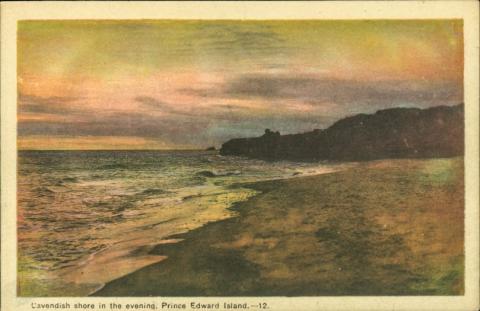
Postcard Caption: Cavendish shore in the evening, Prince Edward Island.
NOTE: This card and the ones that follow (September 1939 to April 1941) are not part of the George Boyd MacMillan Family Collection at UPEI. These are in the Library and Archives Canada, George Boyd MacMillan Fonds. MG 30, D 185, R2277-0-7-E. Images for this paper are not LAC originals but are identical or similar cards from Historic PEI Postcards Collection.
20 October 1939
This is a set of eight postcards mailed from Toronto, after her last visit to Prince Edward Island (from 16 September 1939 to about 18 October 1939).
Postcard 1
This does not show Charlottetown itself. It is taken from the “old French fort” of which only a grassy dyke remains.
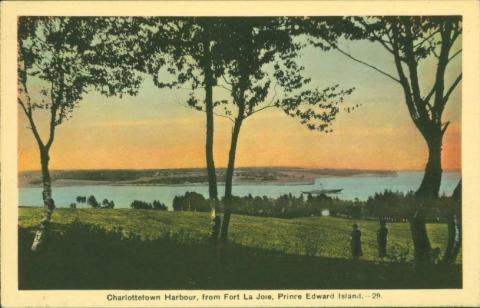
Postcard Caption: Charlottetown Harbour, from Fort La Joie, Prince Edward Island.
Postcard 2
This does not do the view justice being taken from a too low point. From the hill it is one of the finest on the Island.
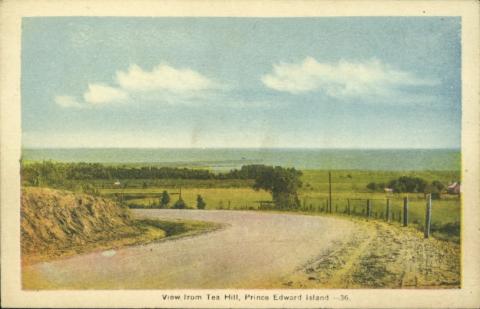
Postcard Caption: View from Tea Hill, Prince Edward Island.
Postcard 3
A scene on one of the new highways. The highways have become necessary but they are very bare and stark yet. Alas for the beauty destroyed making them. But it will return!!!
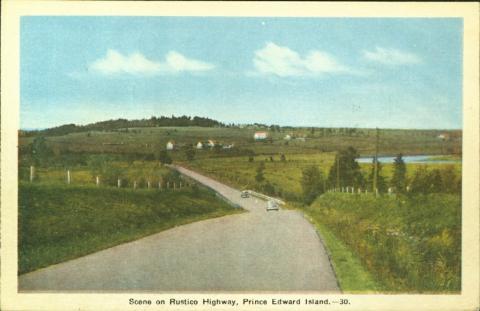
Postcard Caption: Scene on Rustico Highway, Prince Edward Island.
Postcard 4
Even Hitler has no power over a scene like this.
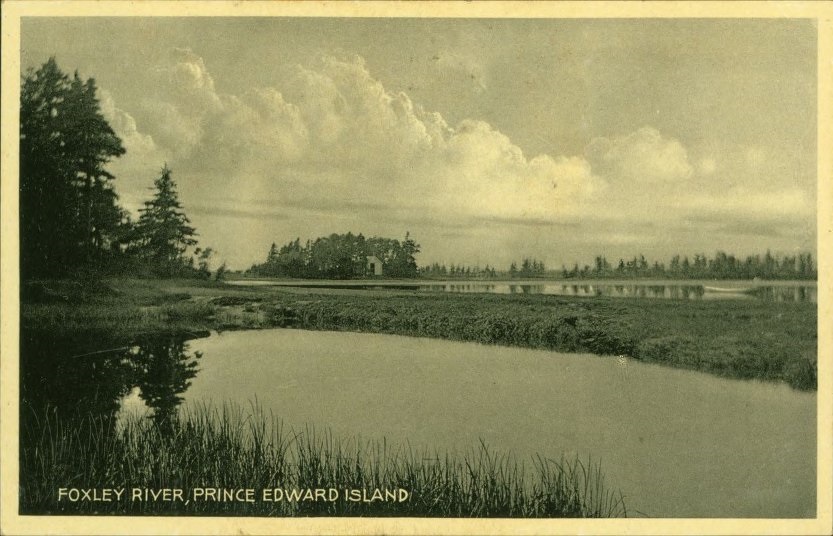
Postcard Caption: Foxley River, Prince Edward Island.
Postcard 5
No text.
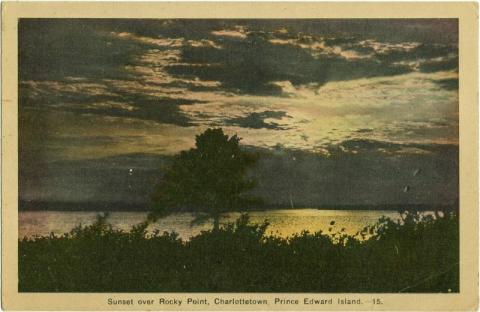
Postcard Caption: Sunset over Rocky Point Charlottetown, Prince Edward Island.
Postcard 6
This used to be the old “Lion Head” but the resemblance has worn away. Yet though the shoreline is always changing a little it seems always the same as the changes come so slowly.
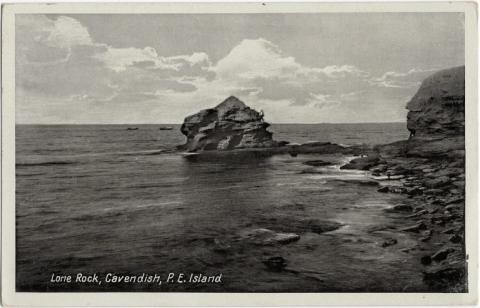
Postcard Caption: Lone Rock, Cavendish, P.E. Island.
Postcard 7
This is a scene “up west.” The Kildare Capes are quite noted on the Island for their beauty.
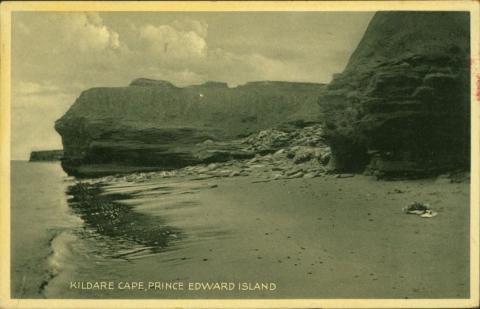
Postcard Caption: Kildare Cape, Prince Edward Island.
Postcard 8
“Slow sinks, more lovely ere his race be run, Along “The Island’s” hills the setting sun.” With apologies to Byron.
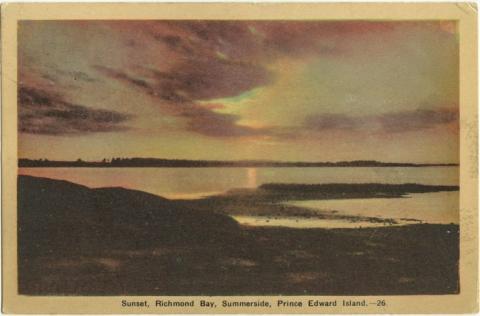
Postcard Caption: Sunset, Richmond Bay, Summerside, Prince Edward Island. [On the original card, LMM strikes through “Richmond” and adds "Egmont Bay" above it.]
Context: George Gordon Lord Byron (1788–1824), The Curse of Minerva. “Slow sinks, more lovely ere his race be run, Along Morea's hills the setting sun.”
21 November 1940
Thanks for magazines. Am very ill. Still not able to write.
Yours as ever
L.M. Macdonald
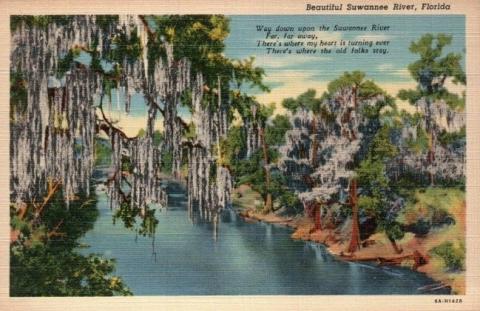
Postcard Caption: Beautiful Suwanee River, Florida / Way down upon the Suwanee River / Far, far away, / That’s where my heart is turning ever / There’s where the old folks stay.
Context: Montgomery’s husband, Ewan, took winter vacations in Florida.
28 February 1941
Dear Mr. M.:
I am no better and fear it will be along time before I am. Yet the doctor claims I am. We are having a very cold rough winter.
Yours as ever,
L.M. Macdonald
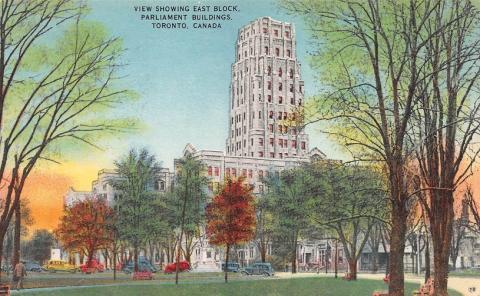
Postcard Caption: View Showing East Block, Parliament Buildings, Toronto, Canada.
23 April 1941
Dear Mr. MacMillan:
Thanks for your card and easter card to-day. The Easter has not yet come as I haven’t had a good time and had a very bad year.
Your old friend
L.M.M.
[On front of original card] I am thinking of your kindness in the kindness of never mentioning the horror. We have lived to see beauty vanish from the world.
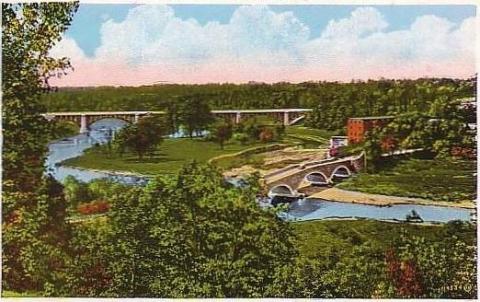
Postcard Caption: The Humber Valley Toronto Canada.
Context: The Humber River was behind Montgomery’s home, “Journey’s End,” in Toronto. Britain and France declared war on Germany on 3 September 1939. Canada entered the war on 10 September 1939. By April 1941 London, Glasgow, Belfast, and British cities were being bombed, Buckingham Palace was hit, German planes dominated the Mediterranean, German U-boats were inflicting damage in the Atlantic, and British forces were retreating from Rommel in northern Africa.30
Acknowledgements: For permissions, assistance, and materials, an abundance of many decades of gratitude to The Heirs of L.M. Montgomery, Inc., Dr. Francis Bolger and Dr. Elizabeth Epperly, Dr. Jennifer Litster, Carolyn Strom Collins, Dr. Mary Rubio, Dr. Elizabeth Waterston, Dr. Kevin McCabe, and Simon Lloyd. Special appreciation to Duncan and Morag McMillan and Ian McMillan for sharing their family history and artifacts. Thank you to Emily Woster, Kate Scarth, Lesley Clement, Jane Ledwell, and Alyssa Gillespie for patience, guidance, and refinement.
About the Author: Mary Beth Cavert, an independent Montgomery scholar with an M.A. in Educational Administration, was a public-school teacher for thirty-four years. She specializes in the personal, historical, and literary context of Montgomery’s kinship ties. Her research has been included in The Complete Journals of L.M. Montgomery, and she has been a contributing writer in L. M. Montgomery’s Rainbow Valleys, The Intimate Life of L.M. Montgomery, and The Lucy Maud Montgomery Album. She authors and publishes The Shining Scroll and the L.M. Montgomery Literary Society social media accounts and web site. She has finished editing the complete correspondence from L.M. Montgomery to George B. MacMillan, L.M. Montgomery’s Letters to Scotland, and is updating a manuscript of Montgomery’s book dedications, L.M Montgomery’s Kindred Spirits. She is a founding member of the board of the Friends of the L.M. Montgomery Institute, a member of the editorial board of The Journal of L.M. Montgomery Studies, and a recipient of the 2020 L.M. Montgomery Institute Legacy Award.
Social Media @LMMontgomeryLS:
Facebook, Twitter, Instagram, Pinterest
Banner image derived from: Pownall Bay, Prince Edward Island Postcard. 1908. KindredSpaces.ca, 1001.SI.LMMGBM.PC.033a.
- 1 KindredSpaces.ca.
- 2 Distad, “The Postcard.”
- 3 Historic PEI Postcards.
- 4 “Louisbourg Cannon.”
- 5 Cavert, “Leaskdale” 41.
- 6 Cavert, “Letters.”
- 7 Montgomery, CJ 2 (16 August 1907): 171.
- 8 Waterston, “Best-Sellers.”
- 9 Images for LMM postcards from May 1904 to July 1939 will be available at KindredSpaces.ca.
- 10 George Boyd MacMillan Fonds.
- 11 “The Louisbourg Cannon.”
- 12 Woster, Books.
- 13 Epperly, Imagining Anne 113.
- 14 Historic PEI Postcards.
- 15 Montgomery, CJ 2 (16 August 1907): 171.
- 16 Montgomery, Letters to Scotland.
- 17 “Scott’s View.”
- 18 “Hole 15.”
- 19 “Pen Mar Park.”
- 20 George B. MacMillan Collection.
- 21 Montgomery, CJ 2 (20 June 1908): 192.
- 22 Montgomery, Letters to Scotland.
- 23 Coates, Photographing.
- 24 “Macdonald Institute.”
- 25 Montgomery, SJ 5 (5 April 1937): 155. LMM copied a letter from Frede written on 24 March 1907 in this journal entry.
- 26 Litster, “Aix.”.
- 27 Montgomery, CJ 3 (14 September 1916): 242.
- 28 “Lauchlan Watt.”
- 29 Cavert 41.
- 30 “Timeline.”
Works Cited:
Cavert, Mary Beth. “Leaskdale and Loss in the Great War.” L.M. Montgomery's Rainbow Valleys: The Ontario Years, 1911–1942. Edited by Rita Bode and Lesley D. Clement, McGill-Queen’s UP, 2015, pp. 35–53.
---. “L.M. Montgomery's Letters to Scotland: Reading Between the Lines.” Journal of L.M. Montgomery Studies, 2020. https://journaloflmmontgomerystudies.ca/reading/cavert/lm-montgomerys-letters-scotland.
Coates, James. Photographing the Invisible: Practical Studies in Spirit Photography, Spirit Portraiture, and Other Rare but Allied Phenomena. London: L.N. Fowler & Co, 1911. Forgottenbooks.com. PhotographingtheInvisible_10271479.pdf.
Distad, Merrill. “The Postcard: A Brief History.” Peel’s Prairie Provinces, University of Alberta, peel.library.ualberta.ca/postcardhistory.html.
Epperly, Elizabeth Rollins. Imagining Anne: The Island Scrapbooks of L.M. Montgomery. Penguin Canada, 2008.
George B. MacMillan Collection. McLaughlin Library, Archival and Special Collections s0235b02, University of Guelph, Canada.
George Boyd MacMillan Fonds. Library and Archives Canada, MG 30, D 185, R2277-0-7-E.
Historic PEI Postcards Collection. CAUL-CBUA Atlantic Islandora Repository Network at University of Prince Edward Island, upei.cairnrepo.org/islandora/object/islandora%3A552?page=3.
“Hole 15.” Alloa Golf Club, alloagolfclub.co.uk.
KindredSpaces.ca. L.M. Montgomery Institute at University of Prince Edward Island, Charlottetown, Prince Edward Island, kindredspaces.ca.
“Lauchlan Watt.” Wikipedia: The Free Encyclopedia. Wikimedia Foundation, 18 Aug. 2020, en.wikipedia.org/wiki/Lauchlan_Watt.
Litster, Jennifer. “Aix.” Received by Mary Beth Cavert, 29 April 2020.
“The Louisbourg Cannon.” The Louisbourg Cannon—Miscouche, PEI—Signs of History on Waymarking.com, waymarking.com/waymarks/wmR73J_The_Louisbourg_Cannon_Miscouche_PEI.
“Macdonald Institute (1903–2003).” Canada Post, 23 June 2003, canadapost.ca.
Montgomery, L.M. The Complete Journals of L.M. Montgomery: The PEI Years, 1889–1911. Edited by Mary Rubio and Elizabeth Waterston, Oxford UP, 2012–13. 2 vols.
---. L.M. Montgomery’s Complete Journals: The Ontario Years, 1911–1933. Edited by Jen Rubio, Rock’s Mills P, 2016–19. 5 vols.
---. L. M. Montgomery’s Letters to Scotland: The Complete Collection of the George Boyd MacMillan Correspondence, 1903–1941. Edited by Mary Beth Cavert. Unpublished manuscript, 2020.
---. The Selected Journals of L.M. Montgomery. Edited by Mary Rubio and Elizabeth Waterston, Oxford UP, 1985–2004. 5 vols.
“Pen Mar Park.” Wikipedia: The Free Encyclopedia. Wikimedia Foundation, 18 Aug. 2020, en.wikipedia.org/wiki/Pen_Mar_Park.
“Scott’s View.” Wikipedia: The Free Encyclopedia. Wikimedia Foundation, 18 Aug. 2020, en.m.wikipedia.org/wiki/Scott%27s_View.
“Timeline of World War II (1941).” Wikipedia: The Free Encyclopedia. Wikimedia Foundation, 19 Aug. 2020, en.wikipedia.org/wiki/Timeline_of_World_War_II_(1941).
Waterston, Elizabeth. “Best-Sellers in English.” The Canadian Encyclopedia, 6 Dec. 2013, Historica Canada. www.thecanadianencyclopedia.ca/en/article/best-sellers-in-english.
Woster, Emily. Books in the Library of L.M. Montgomery. 2011. Archival and Special Collections XZ1 MS A094, L.M. Montgomery Collection, University of Guelph. Unpublished document.
